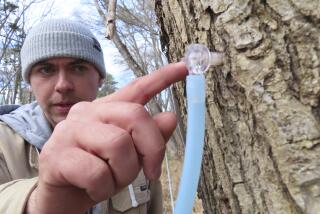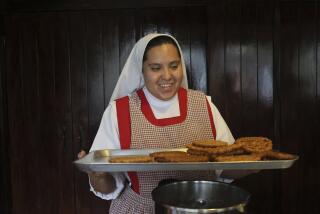Taste of Travel: Connecticut : Sweet Tradition : In a World of Sterile Mechanization, Maple Sugaring Remains Much as It Always Has Been
- Share via
BURLINGTON, Conn. — In the messy cold of late winter in the backwoods of southern New England, metal buckets begin to appear on the trunks of the sugar maples. Somewhere nearby I know there will be a hand-painted sign pointing to a wooden sugarhouse. If steam is billowing out of the roof vents, the sugar maker is certainly sugaring off.
I donned my boots for the short walk from my car to Rob Lamothe’s Sugarhouse in Burlington, on the edge of a woods packed with bare branches and snow laden pines. Evaporating sap simmered over a wood fire tended by Lamothe, a burly bearded man decked out in backwoods garb: a plaid flannel shirt, blue jeans, suspenders and boots. His wife, Jean, stood guard over the sales counter, vending some of the best syrup I’ve ever tasted and the creamiest maple sugar candy on the planet.
This was rather a personal journey for me. I was 9 years old when my family moved here from Upstate New York and I immediately fell in love with the woods and the fresh streams and farms nearby. In early spring I learned to love the tradition of sugar making that takes place to this day in the woods all around.
But this is 1994 and like all Connecticut sugar makers this time of year, Lamothe is incredibly busy. Most days of the year he’s simply a machinist, but in February and March, when the sap is running, he also becomes a sugar maker--before work, after work, on weekends, every spare minute of the day. Pursued the old-fashioned way like this, the process is labor intensive. An average tree yields about 40 gallons of sap in a season, about enough to boil down into a single gallon of syrup. Yet in a good year Lamothe manages to make 400 to 500 gallons, tapping trees around town and paying the landowners back in syrup.
There is an alluring kind of solitude that comes from working in the woods, Lamothe says; a strong connection with nature and with the past. But Lamothe gets the most satisfaction from knowing he is carrying on a family tradition that began in Quebec, as well as passing that tradition on to his children.
“It brings you back in touch with your ancestors. I’m doing something my great-great-grandfather did,” he said, although it was from library books that Lamothe learned the technique, not his family, who had abandoned the practice in favor of full-time factory work when they moved to the United States.
The sap Lamothe brings in from the woods looks and tastes like water, and that’s mostly what it is. But after hours of boiling--after it has reached a substantial sugar content of 66%--he draws off the resulting syrup into plastic jugs. And on weekends--when the sugarhouse is full of visitors--he pours some of the buttery-sweet syrup into tiny plastic cups and hands it around for sampling.
Most maple sap is made into syrup (about $8-$12 for a quart), but some sugarhouses--such as Lamothe’s--also make a maple cream spread ($6 for eight ounces), crystallized maple sugar ($6 for eight ounces) and maple sugar candy ($9 for eight ounces) during the season. Some even give out free snow cones made of maple syrup drizzled over fresh snow.
This is, sadly, an endangered experience. Technology has invaded the forests and the sugarhouses, transforming the winter pastime of Colonial farmers into an industry. In much of Canada and some parts of New England, metal collection buckets have been abandoned and sap is drawn from trees by plastic tubes leading to mammoth barrels, making the forests look as if they’re on intravenous feeding. The sap is boiled off in factories and stored for years in warehouses. Sugarbushes (as wild stands of sugar maples are called) are fertilized by crop dusters.
The traditional methods persist, to varying degrees, in small sugarhouses throughout New England and Upstate New York, but I prefer to hunt maple sugar around home in Connecticut. In Vermont, for example, the big business of sugaring to me has an industrial flavor. But in Connecticut, maple sugaring is still exclusively small business. It is easier to step back in time here, and that is what I like about it.
Sugarhouses like Lamothe’s come about as close to traditional maple sugaring as you can find in the Northeast and it is not all that difficult to erase a century or two from the scene. Imagine that the pickup truck bearing barrels of sap is a horse-drawn wagon and that the big metal evaporator is a big iron kettle. Not much else has changed, and what has changed is discretely tucked away.
Although not as charming to the tourist exploring the rural areas, the technology does have advantages. Lamothe points out that the plastic tubing method protects the trees from damage caused by sugar makers treading upon roots to empty buckets that fill up quickly. And even Lamothe has invested in a modern contraption called a reverse-osmosis machine, which is carefully hidden away in the back of the sugarhouse. This single machine can draw 75% of the water from the sap, substantially shortening the boiling time and, in so doing, saving wood.
About 30 miles away at the Flanders Nature Center in Woodbury, no such machinery is found. The private, nonprofit facility is dedicated to preserving local flora and fauna and related traditions. Tucked deep into the woods, its sugarhouse is stacked to the rafters with split wood to fuel its evaporator. Free sugar making demonstrations are offered every Saturday and Sunday in March, from 3 p.m. to 5 p.m., and if the sap is running, children are invited to help empty the buckets. The syrup is sold at the gift shop in the center’s main building.
From the volunteer sugar makers at the Nature Center I learned that Native Americans taught early Colonists the techniques for extracting sap from trees and boiling it down into syrup. They also shared their methods for making sugar, which keeps longer and is more portable than syrup--two characteristics important to the semi-nomadic Native Americans of the area.
Gazing deep into woods, where the buckets dangle from the trees around the sugarhouse, I got a sense of what Lamothe means: that only by standing near the sugarhouses can you feel the link between us and the Native Americans who boiled sap here in hollowed-out logs, so many years before.
A 10-minute drive down the road in the town of Southbury, David and Betsy Stiles make about 100 gallons of syrup a season on the land David’s family has farmed since 1638. The family’s sugar making tradition reaches at least as far back as Stiles’ great-grandfather.
Inside the family’s rustic sugarhouse, Stiles sits on a tree trunk and tosses wood into the fire in the bottom of a shining copper evaporator that he swears makes better syrup than the modern stainless steel models. With his son, Benjamin, already helping out with the sugar making, Stiles knows the sugar-making tradition will continue for at least another generation. But even though he is 79, he sees no reason to quit. “I’ll keep sugaring as long as I can,” he said.
GUIDEBOOK
Connecticut Sugar Shacks
*
Getting there: Burlington is about 20 miles west of Hartford. Southbury and Woodbury are about 45 miles southwest of Hartford.
If driving from New York City, take Interstate 95 (in the Bronx) northeast into Connecticut, then turn north on Connecticut 8.
To get to Southbury and Woodbury from Connecticut 8, go west (about 15 miles) to Exit 15 (Connecticut 6). The exit is at Southbury and Woodbury is several miles north.
To get to Burlington, take Connecticut 8 north to Exit 42 (Connecticut 4), then go east a few miles into town.
*
Finding sugarhouses: For directions contact individual sugarhouses. Weekends are the best bet for catching a glimpse of the sugaring process because so many sugar makers are hobbyists who pursue the activity on their days off. Weather is the key. Cold nights and warmer days make the sap run; if it falls below 20 degrees overnight and reaches 45 degrees by mid-morning, a five-gallon pail will be overflowing by noon. If it gets too warm, the trees will bud and it will be over.
Flanders Nature Center, Flanders Road, Woodbury, Conn. 06798; (203) 263-3711.
Lamothe’s Sugarhouse, 89 Stone Road, Burlington, Conn. 06013; (203) 582-6135.
Stiles Sugar House, 1127 Main St. North, Southbury, Conn. 06488; (203) 264-5470.
*
Buying syrup: Maple syrup travels and keeps well. It is usually packaged in plastic bottles or metal cans, which should be refrigerated after opening. Larry Myatt, maple agent for the University of Vermont Extension Service, advises transferring syrup to a glass container to protect the flavor. It will keep forever if frozen in small batches, which can be reheated on a stove, he said. Maple candy and maple butter should be eaten fresh.
*
For further information: To receive a free copy of a brochure listing locations of sugarhouses around the state, send a self-addressed, stamped envelope to: Connecticut Department of Agriculture, 165 Capitol Ave., Room 263, Hartford, Conn. 06106; (203) 566-3671. During the season, usually February and March and sometimes a few weeks in April, TVs at the local airport, Bradley International Airport in Windsor Locks, Conn., run videos about maple sugaring in the state. Connecticut’s State Department of Economic Development also has information booths at the airport where brochures with the locations of sugarhouses are distributed for free.
More to Read
Sign up for The Wild
We’ll help you find the best places to hike, bike and run, as well as the perfect silent spots for meditation and yoga.
You may occasionally receive promotional content from the Los Angeles Times.






